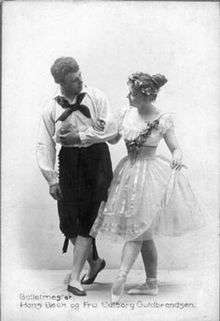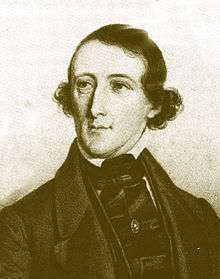Flower Festival in Genzano

The Flower Festival in Genzano (Danish: Blomsterfesten i Genzano) is a one-act ballet by Danish choreographer and ballet master August Bournonville (1805–1879). Bournonville created the work for Denmark's Royal Ballet in 1858 specifically on December 19, 1858, at the Royal Theater of Denmark, on the basis of general enthusiasm among the Danes for Italy. The libretto is adapted from a tale found in Impressions de voyage by Alexandre Dumas and tells the story of a pair of young lovers, Rosa and Paolo, who alludes to the festival that is still celebrated in Genzano, Italy, during the month of June. The music is by Edvard Helsted and Holger Simon Paulli. Bournonville was a dancer, choreographer, ballet teacher and director; son of the dancer and French ballet master Antoine Bournonville, who had been a disciple of the great Noverre. Auguste was born in Copenhagen in 1805, studied with his father and completed his training in France - with the last virtuoso of the French classical style, Vestris - before becoming a star of the Paris opera. But Bournonville's personal contribution to the development of romantic ballet in the course of his long reign as head of the Royal Danish Ballet far outweighed French influence. Bournonville created a repertoire of more than 50 ballets, a school and its own style. The characteristic of his repertoires is that he was able to maintain real characters, that the dancers are as they are (they did not exaggerate the gestures), and looking for exotic places for his works.
Background
The ballet premiered 19 December 1858 in Copenhagen and was danced in its entirety by Denmarks' Royal Ballet until 1929 when it was dropped from the repertoire. The pas de deux was extracted from one of the ensemble dances and lived on in Denmark's Royal Ballet School until Harald Lander, director of the Royal Ballet, once again brought it to the stage in 1949. It is considered one of Bournonville's most perfect compositions. It has to be seen in the Festival of Flowers in Genzano which is a transition to naturalism (one of the stages of Auguste's style) and is characterized as a masterpiece of Bournonville's international virtuosity, so it is a clear example of the Danish style, typical of the Danish school with a very strong and quite good technique, giving greater importance to the feet, that is why he makes use of the vividness and variety of the jumps, the softness of the feet, the speed and brilliance of the small battery. It should be noted that the original ballet disappeared shortly after its premiere because it did not last in time, but in 1875, Bournonville remade a divertiment, in which he kept the deux pas he had used in the montage he had already made in Vienna Festival of Flowers, which remains in the repertoire until 1929 but in 1949 Harald Lander (director of the Royal Ballet) took him to the stage. That is why the entire ballet has not been found but the fragment rescued. It is considered one of Bournonville's most perfect compositions. It is often performed in ballet finery to show the Bournonville style.
Music

The so-called Flower Festival in Genzano pas de deux has become an extremely popular repertory piece with ballet companies and is often utilized in whole or in part by dancers on the ballet competition circuit. The music of this pas de deux is often erroneously credited to Holger Simon Pauli and/or Eduard Helsted in modern theatre programs, films, etc. The true origins of this famous pas de deux stem from an 1842 staging of Bournonville's Napoli for the ballet of the Kärntnertortheater in Vienna. For this production, the danseur Lorenzo Vienna—who performed the principal role of Gennaro in Napoli—created a pas de deux for the third act to new music by the Austrian composer Matthias Strebinger (1807–1874). Bournonville then added the pas de deux to the full-length The Flower Festival in Genzano and the composer of that work, Holger Simon Pauli, adapted Strebinger's music accordingly. For this reason some current companies sometimes insert the pas de deux of Festival de Flores in Genzano in the pas de deux de six of Napoli. Although it is believed that the music of the pas de deux is from the Austrian composer Strebinger, when passing from Napoli it was reorchestrated by Paulli, since he, along with Helsted, had been the authors of the original Genzano Flower Festival, and that is why He continues to attribute to him the authorship of the piece.
The entrée of the pas de deux opens with an episode for solo violin, followed by a polka-like section. After the adage follows the male variation—this is set to a waltz taken from Adolphe Adam's score for Joseph Mazilier's 1845 ballet Le Diable à quatre. The series of relatively short, tuneful passages continues and the pas de deux concludes with a characteristic coda. The music is completely representative of ballet music from the period. As for the decoration know that it was made by Messrs, Christensen and Lund.
Regarding the performance of the work, it should be mentioned that the dancer performs small gargouillade and her round of petit manège, with four grand jetés in the first arabesque at the end of the solo, also, the repeated series of fast relevés at the tip in his second solo, all this is part of the characteristic Bournonville style that uses few familiar steps and also doing a strong job of tip. Also mention a small circle that is performed four times by the couple, with the boy holding the girl, holding him, in a low inclined position and she jumps right while doing fast jambe ronds. We can also observe the game of flirtation between the couple at the beginning of the Coda, a fact that is not found in any Bournonville choreography. Another element that we have found in which it is not usual for Bournonville to use it is the fragment where she is held by the dancer arrives at the position of first arabesque, and then turns to the left which rotates in avant arabesque and then she turns Again to return to the correct first arabesque, it is not a sequence that we usually find in any of the other Bournonville choreographies. In the two solos of the boy they perform steps that use the strong blows of the music. However, in his first solo we observe that he only follows direct lines (performs a diagonal and then moves in parallel) very simple in the use of the stage. The boy's second solo is perhaps the only part that is totally in Bournonville's best known style. Add that after looking at several sources has not been found which dancers made the first Festival of Flowers in Genzano but, however, there are old videos in which the pas de deux rescued is shown. This work is considered different from the other works carried out by Bournonville. The work represents in the life of Bournonville's choreography, the most international, in which the musical and choreographic stylistic peculiarities of the Romantic ballet merged.
See also
References
- Citations
- Sources